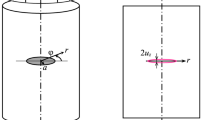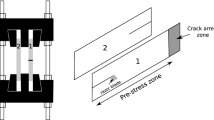Abstract
One of the little-studied problems of modern mechanics and the physics of destruction is crack branching, which is observed in materials of varying nature. In order to study this phenomenon, the criteria and mechanisms for crack branching are analyzed. Studies of crack branching in polymers and steel, as well as fractographic studies of the fracture surface, are considered. It is found that the crack at branching in brittle plastics reaches the limiting propagation velocity V* = 500–800 m/s. Tensile tests of flat samples made of polymethyl methacrylate (PMMA) at temperatures of +20 and –60°C are carried out with measurement of crack velocity by the method of rupture of conductive strips. A measuring device based on a TERCON precision converter of signals of resistance thermometers and thermocouples connected to a computer is created. Crack velocity is measured for (i) rectilinear crack propagation in the mirror, matte, and feather zones of PMMA fracture surface, (ii) single branching of the crack, and (iii) multiple crack branching with parallel movement of the front of several cracks. A hypothesis for the physical mechanism of crack branching is proposed.





Similar content being viewed by others
REFERENCES
Yoffe, E., The moving Griffith crack, Philos. Mag., 1951, vol. 42, pp. 739–750.
Nemets, Ya., Serensen, S.V., and Strelyaev, V.S., Prochnost’ plastmass (Strength of Plastics), Moscow: Mashinostroenie, 1970.
Finkel’, V.M., Fizika razrusheniya (Fracture Physics), Moscow: Metallurgiya, 1970.
Ravi-Chandar, K., Dynamic fracture of nominally brittle materials, Int. J. Fract., 1998, vol. 90, pp. 83–102.
Ravi-Chandar, K. and Knauss, W.G., An experimental investigation into dynamic fracture. III. On steady-state crack propagation and crack branching, Int. J. Fract., 1984, vol. 26, pp. 141–154.
Sharon, E. and Fineberg, J., Microbranching instability and the dynamic fracture of brittle materials, Phys. Rev. B: Condens. Matter Mater. Phys. 1996, vol. 54, no. 10, pp. 7128–7139.
Bedii, I.N., Kinetics of fast cracks and branching, Extended Abstract of Cand. Sci. (Eng.) Dissertation, Kyiv: Inst. Probl. Strength, Acad. Sci. Ukr. SSR, 1990.
Naimark, O.B., Barannikov, V.A., Davydova, M.M., et al., Crack propagation: dynamic stochasticity and scaling, Tech. Phys. Lett., 2000, vol. 26, no. 3, pp. 254–258.
Uvarov, S.V., Experimental study of the effects of the nonlinear dynamics of crack propagation, Extended Abstract of Cand. Sci. (Phys.-Math.) Dissertation, Perm: Inst. Continuous Media Mech., Ural Branch, Russ. Acad. Sci., 2000.
Kobayashi, A.S. and Ramulu, M., Mechanics of crack curving and branching—a dynamic fracture analysis, Int. J. Fract., 1985, vol. 27, pp. 187–201.
Duffy, A.R., McClure, G.M., Eiber, R.J., and Massey, W.A., Fracture, Liebowitz, H., Ed., New York: Academic, 1969, vol. 5, p. 159.
Syromyatnikova, A.S., Alexeev, A.A., Levin, A.I., et al., Mechanisms of fracture of the polymer material in the propagation and branching cracks, Deform. Razrushenie Mater., 2008, no. 2, pp. 33–39.
Alexeev, A.A., Levin, A.I., Syromyatnikova, A.S., et al., Cracks branching in the fracture of cylindrical shells made of carbon steel internal pressure, Deform. Razrushenie Mater., 2008, no. 12, pp. 33–39.
Syromyatnikova, A.S., Alekseev, A.A., Levin, A.I., and Lyglaev, A.V., Crack branching in carbon steel. Fracture mechanisms, Russ. Metall. (Engl. Transl.), 2010, vol. 2010, no. 4, pp. 301–305.
Alexeev, A.A., Syromyatnikova, A.S., and Bol’shev, K.N., Razrushenie tverdykh tel pri bystrom rasprostranenii i vetvlenii treshchin (Fracture of Solids by Rapid Propagation and Branching of Cracks), Saarbrucken: Lambert Academic, 2013.
Author information
Authors and Affiliations
Corresponding author
Additional information
Translated by V. Avdeeva
Rights and permissions
About this article
Cite this article
Alexeev, A.A., Bolshev, K.N., Ivanov, V.A. et al. Experimental Study of Crack Branching Velocity in Polymers. Inorg Mater 55, 1476–1480 (2019). https://doi.org/10.1134/S0020168519150019
Received:
Published:
Issue Date:
DOI: https://doi.org/10.1134/S0020168519150019




